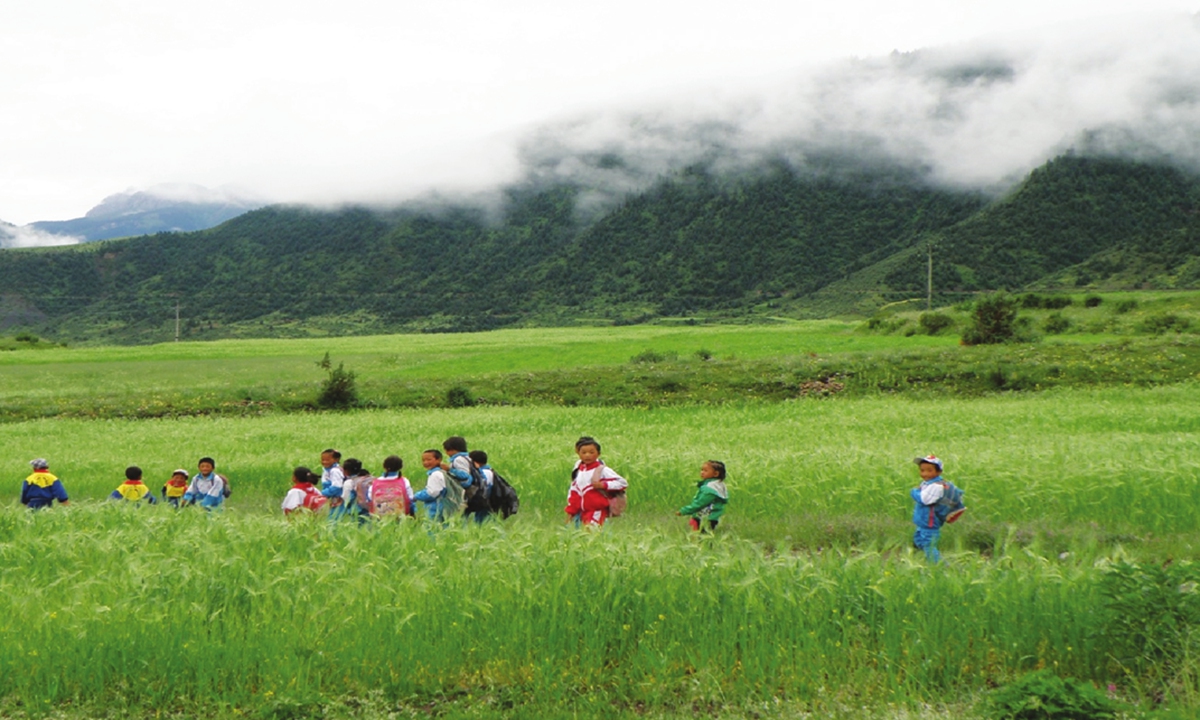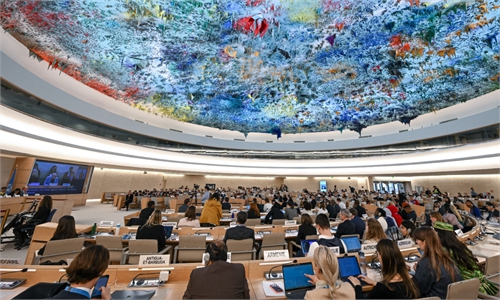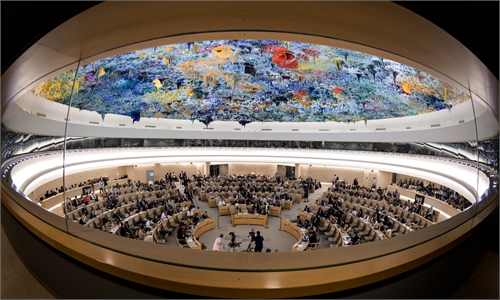
Primary school students on their way to school in Qamdo, Xizang. Photo: Zhaluo
Since May 2021, a large number of unnamed children's graves were discovered near the former sites of Native American residential schools in British Columbia, Saskatchewan, Ontario, Alberta and other provinces of Canada, bringing to light the "dark and shameful" history of colonial residential schools in North America. However, the Western media are exploiting the absurd tactic to divert the focus and launch an attack in the midst of the unprecedented changes unseen in a century.
Recently, there was a hype among so-called human rights defenders that "millions of Tibetan children were separated from their families" and "forced to receive assimilation education in boarding schools," with a particular highlight on the number of "millions" (those Western media also hyped over a million Uygurs were kept at so-called concentration camps in China's Xinjiang.) With the previous real tragedy of the aboriginal boarding schools in Canada, many uninformed people have believed the media and are suspicious of boarding schools in Xizang (Tibet), and even some UN human rights commissioners have demanded an explanation from the Chinese government.
Boarding schools are prevalent in the history of human education, and has been common in Asia and Europe. There are many boarding schools in the western part of China. The boarding schools around the world vary greatly in their effectiveness due to different purposes, teaching contents and management methods, so what is the difference between boarding schools in Xizang? I would like to present board schools in Xizang which are completely from the description of Western media.
I. Why are there boarding schools in Xizang?
There are mainly two reasons for operating boarding schools in Xizang, firstly, the scattered population makes it difficult to build schools nearby; secondly, the mountainous geographical environment poses a great challenge for students on the way to school. Practice proves that gathering students in boarding schools is the most effective way to develop education in Xizang.
1. The Xizang Autonomous Region covers an area of 1.2 million square kilometers, which is equivalent to 5 Britains and 29 Switzerlands, while the population is only 3.648 million (in 2021), corresponding to 5.4 percent of Britain and 41.7 percent of Switzerland. The average population density in Xizang is 3.04 people/square kilometer (sq km), and in fact, except for major regional cities such as Lhasa, other regions have even lower population density, such as 0.33 people/sq km in Ngari region in the west and 1.36 people/sq km in Nagqu city in the north. Xizang is only suitable for valley agriculture, with the narrow arable land and small villages in rural areas, building schools in a scattered way will inevitably result in small scale and irregular education under such conditions.
Before reform and opening up in 1978, Xizang implemented the policy of running schools nearby and having elementary school in every village. Among a total of 6,819 elementary school in the region, there was an average of 38.5 students per school and less than 10 students per grade. The small size of the schools made it difficult to allocate scarce teachers for each grade and each course. Hence, each teacher had to teach multiple subjects, which led to unsatisfactory teaching quality. At that time, data showed that elementary school graduates in farming and pastoral areas were actually only to the level of 3rd grade students.
It was also found that in 1978 the junior high school enrollment rate in Xizang was 6.5 percent and the high school enrollment rate was 5.3 percent, indicating very few rural students were enrolled in secondary schools, which is the result of the imbalanced development of urban and rural education. Only by gathering students through boarding schools and running large-scale schools can we integrate educational resources and provide professional education.
2. The geographical environment of Xizang is special, with the Himalayas in the south and the Hengduan Mountains in the east, the vast majority of which are high in the mountains and deep in the valleys, making road travel extremely difficult. Although the government has increased the construction of roads and railroads in recent years up to 120,000 kilometers, the dangers of road travel still cannot be ignored. Many farming and herding families have shook off poverty yet are still incapable of buying cars, and children have to walk to school every day for a long time through mountains and waters, which is arduous and full of danger. Therefore, it is important to provide those children of farmers and herdsmen in remote areas with accommodation in order to minimize the dangers on their way to school. Only when the safety of students is guaranteed will their parents feel assured and send their children to school.
When Xizang was peacefully liberated in 1951, there was not even a modern school in this area. To boost regional development, it was necessary to cultivate local talents on a large scale based on the development of education. How to develop education under the special conditions of Xizang has been explored in various ways over the decades, such as horseback elementary school (teachers riding horses on the grasslands for door-to-door teaching), tent schools, agricultural off-season schools, night schools, etc. In fact, as early as 1950s, boarding system was already implemented in Xizang for border areas and vocational training, which was found to be effective.
However, the government lacked the financial support to provide accommodation and catering for more students. After the Second Symposium on Tibetan Work of the Central Government in 1984, in response to the lagging development of education in Xizang, it was proposed that education in farming and pastoral areas should adopt the boarding school system, and the central government should offer financial support. Since then, boarding schools in Xizang have developed rapidly. The past decades have proved that the development of boarding education in Xizang is in line with its actual conditions and the laws of modern education, which is also the most suitable mode for students and families.
II. Characteristics of boarding schools in Xizang
Over the past 40 years, the infrastructure of boarding schools in Xizang and the standard of living allowance for students have all improved significantly, the management and care for students have become increasingly mature and standardized. In Xizang, no matter where you are, the best building in the area is the school. In the author's opinion, the boarding schools in Xizang have the following characteristics.
1. Boarding schools in Xizang are all semi-boarding, that is, students live in school from Monday to Friday, and go home on weekends. In some schools in pastoral area, students' families are far away, so the "concentrated weekend" is popular, i.e., students go to school for 10 or 20 days in a row, and then take 4 or 8 days off, so that they can extend the time with their families and reduce the hardship and risks on the way. Students can leave school at any time out of diseases and other personal issues.
Parents of students are also free to visit their kids at school at any time apart from the class hours. In other words, students in Tibetan boarding schools are in school about 200 days (40 weeks) and at home about 165 days per year, and their access to family education (such as traditional culture and native language) as well as communication and affection with their families are barely influenced.
2. The boarding system is mainly for the children of farmers and herdsmen whose families are far away from the school. When students stay in the school, they can enjoy teachers' tutoring during after-class time, and achieve better academic results. Therefore, some students living in urban areas also apply for boarding, which is allowed by the school on a voluntary basis. Children from farming and herding areas are also allowed to leave school and live with their parents as their parents move to cities. In fact, the "in" and "out" changes of boarding students are happening every day given Xizang is in a stage of rapid development.
3. Boarding school students are covered by the "three-guarantees" policy, i.e., the government pays for students' food, accommodation and study expenses. In 2023, the average financial support for each student will be RMB 4,000-5,000 yuan every year, with slight differences in the actual implementation of the policy according to the altitude and economic development of the local area, which is divided into three categories. Boarding education significantly reduces the educational burden of families and creates positive incentives for parents' willingness to send their children to school, which is an important reason for the continuously increasing primary and secondary school enrollment in Xizang.
4. Boarding schools, like other schools in Xizang, practice "bilingual education", that is, learning Tibetan and Putonghua, and most schools also offer foreign language classes, mainly in English. Learning and using the national common language is a normal practice all over the world, which facilitates inter-ethnic information exchange and unity, while Tibetan is a widely used language for social communication in local farming and herding areas. In 2022, the author conducted an research at the No. 1 Middle School in Qamdo City, eastern Xizang, where middle and high school students have four Tibetan classes per week, the same number of hours as other major subjects such as mathematics.
The percentage of students taking the Tibetan language exam remains consistently high; In Qamdo City, for example, 94.08 percent of minority candidates (3,698) took the Tibetan language exam in 2020, 94.89 percent in 2021, and 93.72 percent in 2022. In fact, Tibetan language education in Xizang has formed a complete and mature system from pre-school to doctoral level. It can be said with certainty that more people in Xizang now have mastered the Tibetan language than at any time in history, and the enrollment rate in primary and secondary schools in Xizang is almost 100 percent, the highest percentage of educated population in history.
5. After years of exploration, Xizang has developed a boarding school management system with distinctive local characteristics: each class is equipped with a full-time teacher to take care of students' lives, the daily diet emphasizes nutritious meal preparation with a reasonable mix of traditional Tibetan foods (such as tsampa and ghee tea), cultural and sports activities including traditional Tibetan songs and dances are carried out in spare time, students can leave school when they are sick or other important matters, parents are free to visit their kids during non-class hours, and meetings between the school and parents are held regularly. Since Tibetans make up 85.7 percent of the total population in this area, the vast majority of teachers and students in schools are from Tibetan, Monba and Lhoba people, and 73 percent of all teachers in Chamdo are Tibetan, there is a favorable environment for learning and using their ethnic languages on campus, while students' mastery of native languages is unaffected.
In short, the residential education in Xizang is carried out in a standardized and humanistic way, with nothing in common with the coercive and abusive practices in North American Native American boarding schools. Actually, boarding schools in Xizang are very popular among local residents, who will take pride in the fact that their children are enrolled in high-level boarding schools.
III. How can we evaluate boarding schools in Xizang?
The Tibetan people have the most right to evaluate whether the local boarding school is effective. The author believes that the following three aspects deserve special attention.
1. Boarding schools have guaranteed the right to education of children from farmers and herdsmen families in remote areas of Xizang to the maximum extent. Due to Xizang's special geographical conditions and population distribution, the effect of running schools in close proximity is not ideal and is bound to cause a gap between urban and rural education. After the implementation of the boarding system, rural students and urban students share high-quality educational resources, and the difference between urban and rural education is gradually reduced. It is because of boarding education that the majority of youth in rural and pastoral areas stand on the same stage with urban students. People who have been just lift from poverty deeply realize that education is the most effective way to change the fate of individuals and the plight of families, boarding school is exactly an example that changs the fate of many youngsters in remote areas.
2. Boarding schools have cultivated plenty of high-quality talents for the development of Xizang. Similar to other regions in China, Xizang calls for talents in various fields in rapid growth. In recent years, there are nearly 20,000 college graduates in Xizang every year, and they have made significant contribution to the modern development of Xizang. Without boarding schools, it would be impossible to train so many talents. As Xizang is stepping into modernization, it is also the dream of millions of young people to receive modern education and engage in modern occupations.
3. The life and study in boarding schools also exert a positive impact on the growth of students. For example, the height and weight of Tibetan students have shown significant increase and their health has improved with the nutritious meals and reasonable diet mix in school.
In conclusion, boarding schools constitute a form of education where its content differs between places and schools. Hence, it is irrational to attach a label of "original sin" on boarding schools just because of the shocking tragedies in Canada, Australia, and the US, and to take it as a way to smear the boarding education in Xizang, which is a quite superficial excuse. Interpreting the newly introduced "15-year free education" in Xizang as an extension of personal control over the youth is even more contrary to the public perception of the essence of education, as the increasing of years of education means the accumulation of knowledge, labor ability and self-awareness, which are also important development indicators proposed by the United Nations. As a matter of fact, residential education is full of diversity, humanity and vitality in other parts of the world, including the Xizang Autonomous Region of China, which provides a favorable environment for many youngsters, and becomes the key to a brighter life.
The author is head of the social economy institute of China Tibetology Research Center. opinion@globaltimes.com.cn


